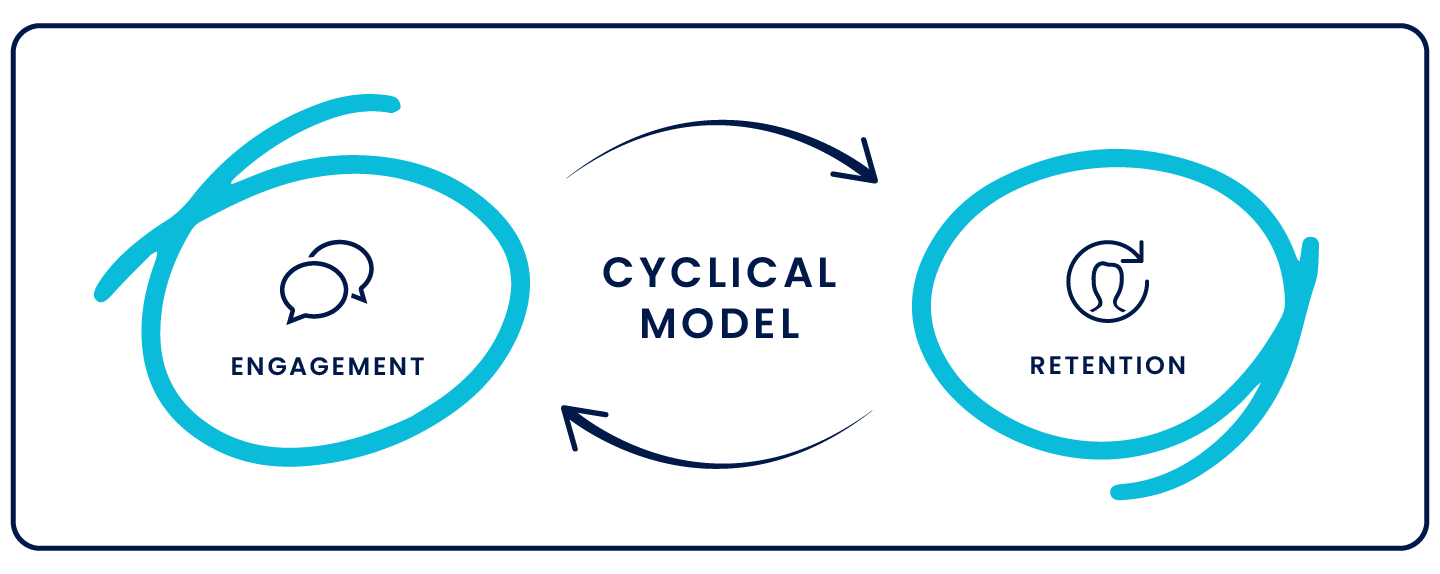Keeping Your Top Performers Motivated: 20 Strategies for Engaging High-Potential Employees
How far can your top performers go? Most organizations aren’t engaging their workforce enough to measure the distance. What they think looks like high achievement may actually be far short of what’s possible.
So what’s holding your organization back?
Engaging high-potential employees is about more than just keeping them happy. You must empower them to excel in three ways:
- In their roles
- Within their departments
- As part of the company as a whole
Employee engagement is a huge piece of the performance puzzle. It’s why we’ve tied performance management to employee engagement. It makes sense that your top performers – or those growing to become them – are also your most engaged. But what happens if that stops?
To learn more, you can request a demo of our software here. Otherwise, keep reading to learn strategies to improve employee engagement.
What are employee engagement strategies?
Employee engagement strategies are methods used to:
- Cultivate a positive work environment
- Boost morale
- Increase productivity
Your organization may have other goals related to employee engagement. Often, HR teams and people leaders won’t look at engagement until something goes wrong. This could be low retention, poor performance, or burnout. It’s important to note that just like the reasons to care for employee engagement are different, so are the strategies.

21 Strategies for Engaging High-Potential Employees
High-potential employees aren’t the only ones you need to focus on. Employee engagement across your workforce encourages everyone to be better. No one wants to be bad at their job! Encouraging them to be active and engaged can change the way they perform in weeks or months.
This is the type of work that many HR leaders wanted to get into when they started. They want to improve lives, help people stay where they are, and help organizations thrive.
1. Present and attentive leaders
Present and attentive leaders play a crucial role in engaging high-potential employees. Their guidance, support, and active listening create a positive work environment. Top-performers have a goal of being among those leaders.
To help with engagement, bring your top-performers into your leadership circle! Ask their opinions, collaborate with them, and give them credit when you use an idea. This is also a great strategy for people who could be high performers, but they aren’t putting in the effort.
2. Help HIPOs See Themselves as HIPOs
Helping High-Potential Employees (HIPOs) recognize their own potential is key. Often, they are dealing with things like imposter syndrome, even if you don’t think they are.
Provide feedback and opportunities to empower them. This allows them to see themselves as valuable assets to the organization. You’d be surprised which employees don’t think they’re doing a good job when they really are!
3. Recognize Talents and Brainstorm Together
Acknowledge the unique skills of your high-potential employees. We all have goals of creating unique, innovative workforces. So much so that we hire specifically for it!
But, once they are in your workforce, are you using them appropriately?
Encourage collaborative brainstorming sessions to leverage their talents and foster innovation. You can’t always do this, but when you have the time, it makes a huge difference. Bring different people together to see what magic can happen.
4. Pair Recognition with Collaborative Discussion
Recognizing high-potential employees should go hand in hand with open discussions. Everyone likes to get an award or a box of cookies as a way to acknowledge their hard work. However, you do need to go a little further with it.
Encourage collaboration and feedback to show appreciation effectively.
Engagement thrives on mutual understanding and shared goals – so you have to put in the effort too. But it doesn’t always have to be HR! It can be team managers, senior leaders on the team, or other members of the C-Suite.
5. Avoid Promotion-Focused Direction
When engaging high-potential employees, focus on growth over promotions. This can actually lead to discouragement. Why? There are two main reasons:
- There’s a fairly pervasive rumor out there that high-performers don’t get promoted. This is because they need to continue being successful.
- If the promotion doesn’t happen quickly, it can feel like the high-performer is being limited.
Encourage skill development and personal progress over pushing for upward mobility.
6. Develop a Culture That Provides Regular Opportunities for Growth Conversations
It’s not enough to say you offer growth! You need to have conversations about it! These conversations aren’t just for HR and managers. It needs to be a conversation between HR, C-Suites, managers, employees, and more.
Foster growth by encouraging regular conversations about development. Create a culture where employees feel supported and motivated to enhance their skills.
7. Communicate Employee Engagement Strategy
Communicating your employee engagement strategy aligns everyone to a common goal. There isn’t any shame in having this discussion! Often, HR leaders want to hide their engagement strategy. It’s a good thing if your employees know you are thinking about making the workplace better for them.
There are some cautions when you are communicating your employee engagement strategy. Be transparent, clear, and consistent in sharing the plan. This will inspire commitment and cultivate a positive work environment.
8. Hire with Employee Engagement in Mind
When hiring, consider how candidates align with your employee engagement strategy. This may seem strange, but you don’t want to bring in a bad apple to your workforce.
Look for applicants who value growth opportunities and a collaborative work environment. This will ensure you’re bringing in engaged people. It will also keep your existing high-potential employees motivated and engaged.
9. Leverage Onboarding Tools and Employee Training
After you hire high-potential employees, you need to onboard them. Providing effective employee training is key. Why? Historical high-performers want to start their new job quickly. They don’t want to mess around – they have an impact to make!
Onboarding tools such as a training management system can help keep you organized. Enroll your new hires in training as soon as they start, then allow them to take the training on their own time, at their own speed. Mitratech’s training management helps you administer training, and see the results of your onboarding.
These resources help new hires integrate into the company culture and hit the ground running.
10. Work on Professionally Developing Your Employees
Don’t stop with onboarding! Invest in training programs, workshops, and mentorship to enhance your employees’ skills. Professional development contributes to their growth and boosts engagement within the organization.
Click here to learn more about building a mentorship program.
11. Improve Retention
Improving retention through employee engagement is crucial for retaining top talent.
Why?
People are more likely to stick with a company that has people they know. This is why we often see a waterfall effect when one person leaves a team or a company. Engagement and retention are cyclical – they influence each other.
Create a positive work environment that values and nurtures high-potential employees to foster loyalty and commitment within the organization.

12. Conduct Employee Surveys
Conducting regular employee surveys is crucial for gathering feedback. Engagement surveys give your employees a place to explain what’s actually happening. Are they overwhelmed? Tired? Scared about the future? Concerned? Happy? Approaching burnout?
Use anonymous surveys, ask specific questions, and take action based on the results to improve engagement.
Stuck for questions to ask on your engagement survey? See this great resource for over 250 questions.
13. Identify The Drivers Of Employee Engagement
Understanding what motivates employees is crucial. Identifying the key drivers of engagement can help create a workplace where high-potential employees thrive and contribute their best effort every day.
You can do this through open conversations, engagement surveys, or running a poll. What drives engagement might surprise you!
14. Spend Time With Employees
Building relationships with employees is crucial. Spend quality time getting to know them personally. Show you care about their well-being and professional growth for better engagement and retention. It doesn’t have to be any over the top (but it can be).
Even if you are remote, getting your team together can build relationships and engagement. There are plenty of options for remote team building out there!
15. Good Leaders Are Meaning Makers
Good leaders create meaning for their high-potential employees. They do this by aligning their work with a greater purpose. They inspire and motivate, fostering a sense of fulfillment and accomplishment in the workplace.
Always tell your team their “why.” There’s a reason for everything we do. Too often, we undermine ourselves and our team by saving things like, “We’re not saving lives here…”.
Remove that phrase from your vocabulary! There are other ways to encourage employees to not take things to heart.
16. Provide More Than Just A Job
Employees want more than just a job. They seek purpose, growth, and development opportunities. Providing a fulfilling work environment goes a long way in engaging high-potential employees.
17. Establish A Clear Vision For The Future
Establishing a clear vision for the future is crucial in engaging high-potential employees. This doesn’t mean just their future! It means the future of the product or service you sell, the department, the company, and yes, them.
By outlining where the company is headed, employees feel motivated. They can also align their actions and personal goals to those of the company.
18. Promote Open Communication
Encouraging open communication fosters trust and engagement. You’ve heard it before, but it’s the truth.
Create a culture where employees feel heard, valued, and free to share ideas without fear of judgment. Open dialogue leads to innovation and collaboration. If someone does say something “wrong,” don’t reprimand or punish them. Explain your thought patterns in a calm way.
Hard conversations are uncomfortable. But sometimes, they’re what you need for engagement.
19. Provide Professional Development Opportunities
Offering professional development opportunities is key to engaging high-potential employees. Providing training, workshops, and skill-building programs shows commitment to their growth within the organization.
Struggling to create a professional development plan that works? Consider investing in a learning management system that will grow with your organization.
20. Create A Corporate Giving Program
One impactful way to engage high-potential employees is through a corporate giving program.
Encouraging altruism and community involvement can foster a sense of purpose and fulfillment within your team. It doesn’t have to be something big!
Employee Engagement: More Than Just Happy Employees
Employee engagement goes beyond surface satisfaction. It’s about creating a strong emotional connection between employees and their work. This will lead to increased productivity, loyalty, and overall performance within the organization.
How to implement and make the most of employee engagement strategies?
To implement employee engagement strategies effectively, ensure clear communication, provide resources for growth, and recognize achievements. Encourage open dialogues and ongoing feedback to create a culture of continuous improvement and motivation.
Click here to read more about implementing an employee engagement strategy.
How to Develop an Employee Engagement Strategy
Developing an employee engagement strategy involves understanding your team’s needs, providing growth opportunities, fostering open communication, and recognizing achievements. It’s about creating a positive work environment where employees feel valued and motivated.
Fostering employee engagement strategies tailored towards high-potential employees is essential for unlocking their full potential and maximizing their contributions to your organization’s success.
Got the resources to meet return-to-work challenges?
Mitratech offers the right solutions and support to help you pivot to meet post-pandemic demands.



